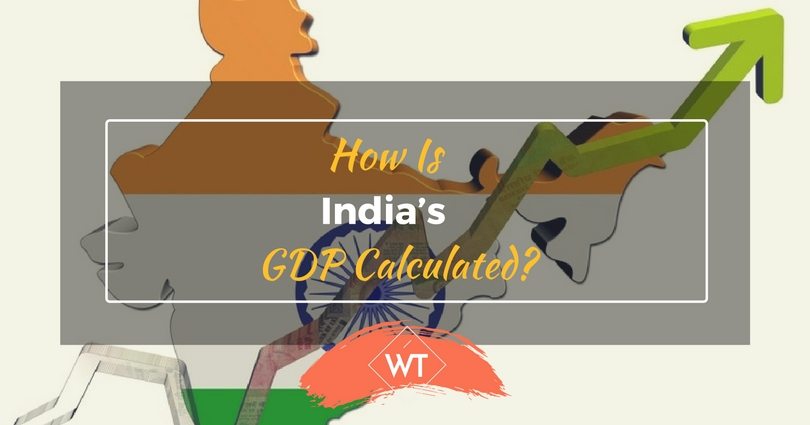How is India’s GDP Calculated?

We keep hearing that India will grow at a GDP of 9% this year and possibly 8.5% next year. Have you ever wondered what this really means and why is this number so important? Let dig a bit deeper to understand how gdp is calculated.
What is GDP?
Gross Domestic Product (GDP) is the measure of a country’s economic performance during that particular period. There are three important components of Indian Economy.
Manufacturing: i.e. cars, steel i.e. industrial activity have 22-23% contribution.
Services: Banking, IT services have 60% contribution.
Agriculture: Farming, rice, wheat have 16-17% contribution.
How is GDP calculated?
It is the market value (or real value on constant price) of all the goods and services produced in a year/ quarter. ‘Cost factor’ or ‘Actual price’ method – these are the two measurement methods to calculate Indian Gross Domestic Product. Market value or ‘Actual price’ method can be determined by taking current prices of goods and services multiply it by volume which automatically includes inflation i.e. price rise.
This may not be real indicator of how much the country is producing with respect to last year or last month. So we have one more method just to know the ‘Real Value’ or ‘Cost factor’ of the GDP i.e. in order to k now the volume growth by keeping prices constant. This method indicates the true level of industrial, agriculture and services growth.
GDP can be calculated in three different ways namely through the product (or output) approach, expenditure approach and income approach. In a way all the three are part of a cycle.
- The product (or output) approach is the most direct one which calculates the total product output of each class.
- The expenditure approach calculates the total value of the products like steel, coal, fridge, TV among many other bought by an individual or consumer like you and me which should be equal to the expenditure of the things bought.
- The Income approach calculates the sum of all the producers’ incomes where the incomes of the productive factors are equal to the value of their product.
GDP = consumption + investment + (government spending) + (exports − imports)
Where,
• Consumption includes personal expenditures pertaining to food, households, medical expenses, rent, etc. It is a major contributor for Indian GDP. It has almost 60 % weightage in GDP.
• Investment as capital which includes construction of a new mine, purchase of machinery and equipment for a factory, purchase of software, expenditure on new houses, buying goods and services but investments on financial products is not included as it falls under savings. This is the second largest contributor of GDP. It has approx. 32% weightage in the GDP.
• Government expenditures on final goods and services which include investment expenditure by the government purchase of weapons for the military, and salaries of public servants etc.
Govt expenditure is very important at the time economic crisis as in 2008-09. Govt comes as a rescue to keep the consumption or investment growing during the unfavourable economic condition.
• Exports which include all goods and services produced for overseas consumption. It has 20% weightage in the economy. It has the ability to generate mass scale employment through textile, Gems and jewellery.
• Imports which include any goods or services imported for consumption and it should be deducted to prevent from calculating foreign supply as domestic supply. It has almost 26% weightage. Company A begins production (example: fridge) by using factors (example: labour like you & me and capital) and then company
A pays workers incomes which they eventually spend purchasing items of their need. So, whichever way you take it, each of the estimates (i.e. spending on fridge, your Income) should provide you the same GDP. But all these calculations have errors and in reality we never have one figure matching with each other.
In India, for all these years we have been getting GDP Product-wise i.e. we have 8 sectors (agriculture, mining, manufacturing, electricity etc.), we calculate how much has been produced (value added that is) in each sector and aggregate it to get GDP figure. We also get GDP based on state levels.
The EAC (Economic Advisory Council) report also said India needs to look at sprucing up exports but we don’t see that happening. The exports as a % of GDP has been stagnant and was at 20.4% in 2010-11 compared to 18.4% in 2004-05. The same figure for imports has risen from 16.1% to 25.6% in the same period.
Hence a bit of mixed evidence, we see investments increasing but exports are falling. With rupee appreciation, the exports are going to fall further this year.
Why is it all important?
We learnt how is gdp calculated. But why is this important. The gross domestic product (GDP) is one the primary indicators used to gauge the progress of a country’s economy.
A GDP of 8% or more for India means better growth. If GDP growth is increasing then it means economy is generating more employment hence there are more number of people who are living better life than yesterday.
Hence it is very important to make GDP growth widespread. GDP growth should be result of growth in all verticals i.e. agriculture, manufacturing and services.
Conclusion
India GDP has three contributing pillar namely Services, Manufacturing and Agriculture. Service is the biggest contributor followed by manufacturing and then agriculture. India CSO (Central Statistics Office – Indian Govt) calculates GDP data from all methods i.e. expenditure and production method.
It gives estimation of which sector is growing and hence which are the main contributing factor. It reveals so many economic data which tells us about different moving part of the economy. Hopefully this has been a good primer on how gdp is calculated.









Leave a Reply